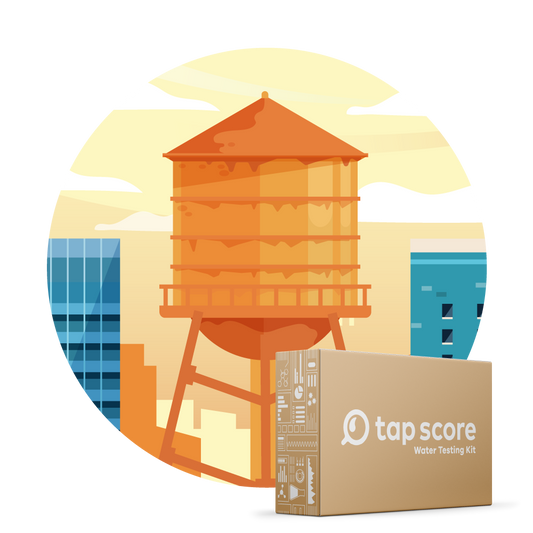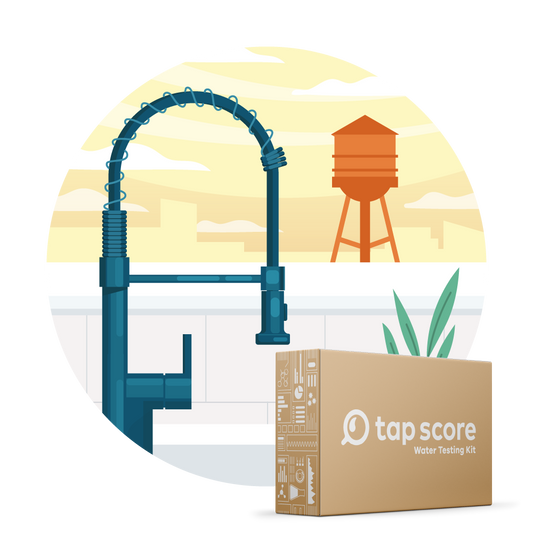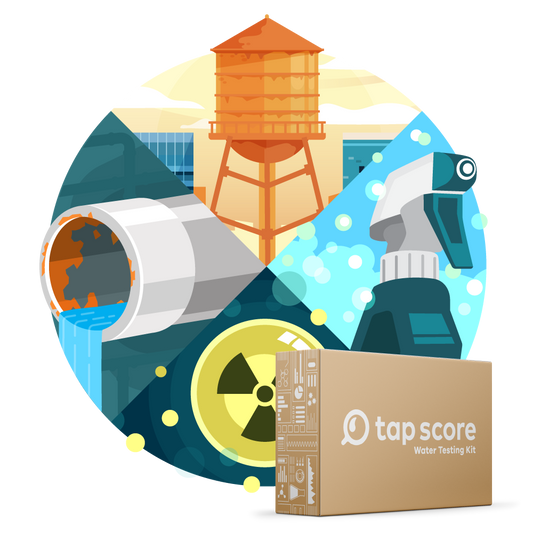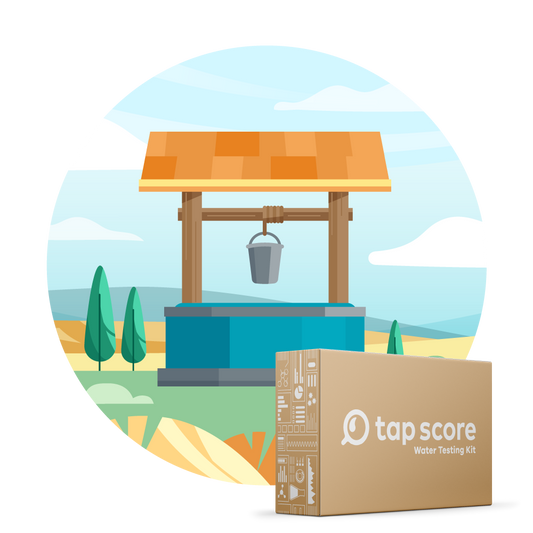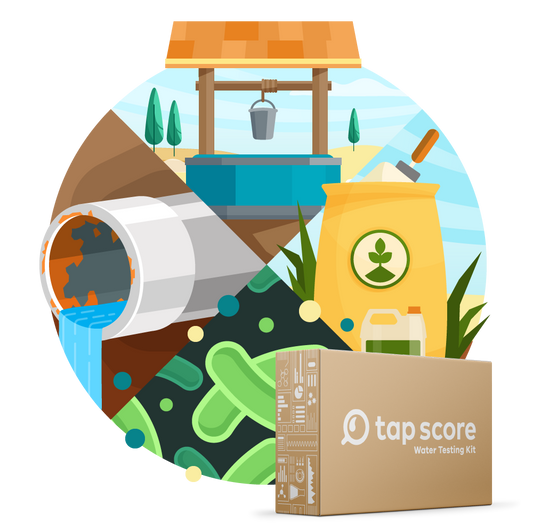
How Does Agriculture Pollute Private Wells?
Our blog is written by real experts— not AI. Each guide is carefully reviewed and updated based on the latest research. Plus, with no affiliate links, you can count on unbiased insights you can trust.
Farming practices (particularly “factory farming”) which include the use of pesticides and nitrate-rich fertilizers have long been a source of well water contamination. If you live near agriculture, should you be worried about drinking your well water?
In this article, we’ll explore your potential contaminant risks, along with information on how to best test and treat your well water.
Table of Contents:
- How Does Agriculture Impact Well Water Quality?
- Agricultural Contaminants that Can Enter Your Well
- Why Is Testing Your Well Water for So Important?
- What Can I Do About Agricultural Contaminants?
Key Takeaways:
-
Runoff is the primary way agricultural pollutants enter well water supplies. Farming practices can contaminate well supplies with:
- Nitrates
- Bacteria
- Heavy metals
- Pesticides
- To understand your risks from potential agricultural pollution as well as what to do about it, you should test your well water.
- Depending on your well water’s specific contaminants, activated carbon filters, nanofiltration, and reverse osmosis can help treat water with agricultural contaminants
How Does Living Near Agriculture Affect Well Water Quality?
Contamination of well water near agricultural operations is largely the result of runoff. The precise way your water is affected depends on a number of factors, including the type of farm and the kinds of pesticides (which include herbicides, insecticides, and fungicides) and fertilizers (including biosolids) used. The depth and age of your well, the region’s water table, subsoil, and bedrock all play a role as well.
The primary contaminants from agricultural runoff include:
- Nitrates
- Bacteria
- Heavy metals
- Pesticides
- Emerging contaminants (including PFAS and PPCPs)
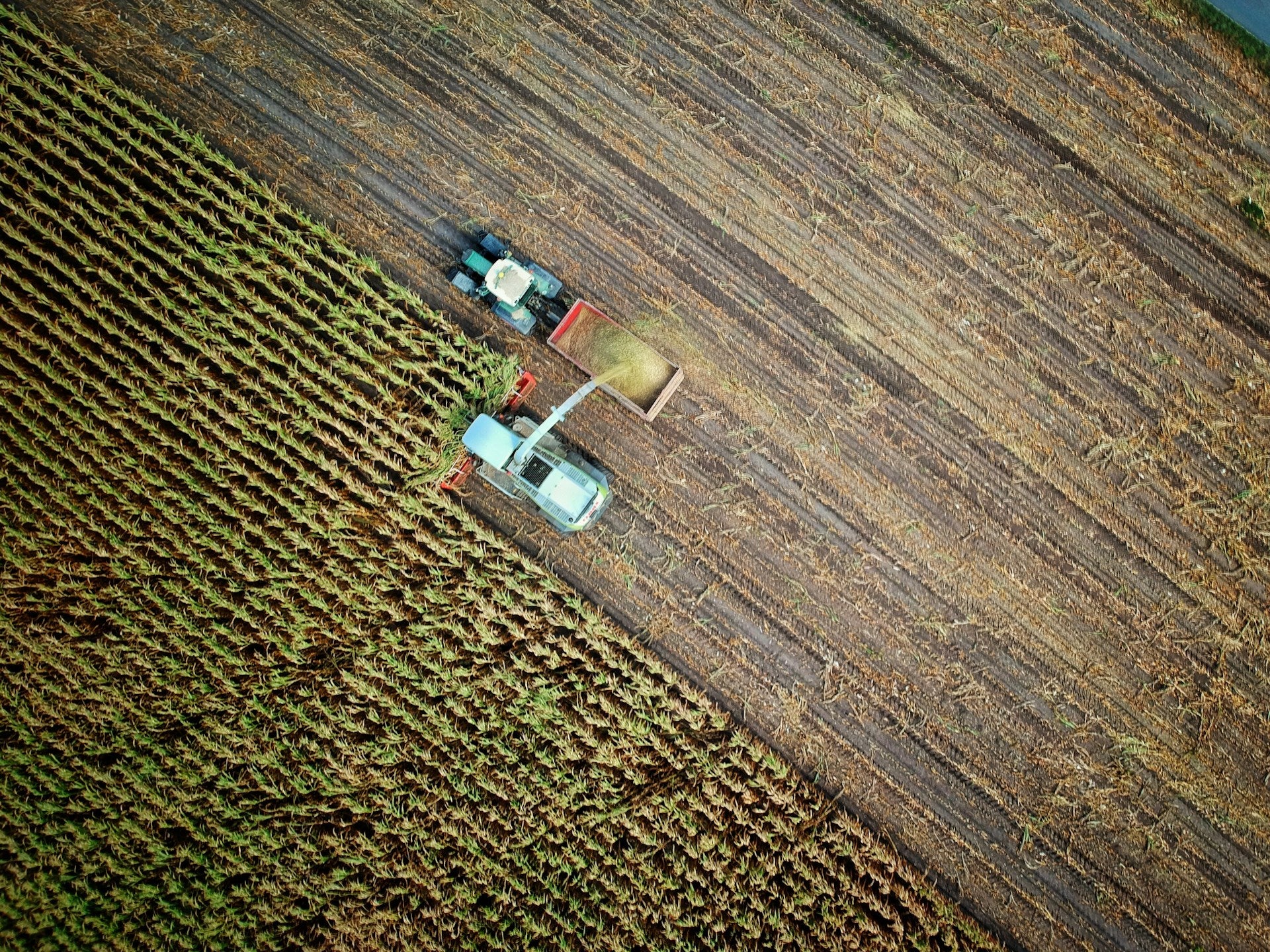
What Is Agricultural Runoff?
Agricultural runoff is water from irrigation, rain, or snowmelt that does not soak into the soil but instead travels along its surface into streams and other water sources, collecting all sorts of contaminants in the process.
Agricultural contaminants also leach or seep into the soil and penetrate down to groundwater sources, like aquifers. Wells draw their water from aquifers.
What Are Biosolids?
When wastewater is processed, solids are separated from liquids, with the solids then being treated to produce a nutrient-rich biosolid. They often sell this “sewage sludge” to farms to be used as fertilizer.
Wastewater treatment plants in rural areas also dump a lot of contaminant-rich sewage sludge directly into potential water sources like rivers and streams.
Drinking Water Contaminants from Agricultural Pollution
Agricultural activity can pollute well water with the following contaminants:
- Nitrate (from fertilizer and manure)
- Coliform bacteria (in areas near livestock operations)
- Pesticides
- Emerging contaminants (like PFAS from biosolid applications)
- Heavy metals (often found in pesticides and fertilizers)
Nitrates (& other nutrients)
High nitrate levels can be harmful, particularly to infants and pregnant women. Nitrogen and phosphorus-rich fertilizers make up a large part of the runoff that leaches into water sources and elevates nitrate levels in drinking water supplies.
Surveys by the USGS found that one quarter of the shallow wells tested underneath or nearby heavily farmed areas were contaminated above the EPA limit (10 PPM). Almost three quarters of the communities with nitrate levels in drinking water at or above 10 PPM are found in only five states: Arizona, California, Kansas, Oklahoma, and Texas.[1]
Coliform Bacteria
In addition to nutrients like nitrates and phosphorus, livestock waste from sprawling animal feed farms can potentially introduce harmful coliform bacteria into well water supplies.

Heavy Metals
Heavy metals (like cadmium, arsenic, lead, etc.) enter well water sources largely due to their presence in certain fertilizers. Analytical testing of some industrial-grade fertilizers have revealed concerning levels of arsenic, cadmium, and lead.[2] Lithium is also found in fertilizers and potash mixtures.
Analytical testing of both glyphosate-based and non-glyphosate-based pesticides revealed elevated levels of arsenic, chromium, cobalt, lead, and nickel — heavy metals all linked with toxic effects in humans.
Pesticides (incl. herbicides, insecticides, & fungicides)
Pesticides can contaminate groundwater sources by seeping into the soil. They spread easily too, and end up in water sources through rain, runoff, and wind. These chemicals can stay in groundwater for decades, even if efforts are made to reduce pesticide use above ground.
Traditionally, insecticides have been considered more harmful to humans than herbicides because of the biological differences between humans and plants. Nevertheless, organophosphate pesticides (which include both herbicides, like glyphosate, and insecticides, like chlorpyrifos) are considered the most harmful pesticides to humans.[3] Some of the more concerning pesticide compounds include:
- 1,2-Dibromo-3-chloropropane (dibromochloropropane or DBCP, discontinued but environmentally persistent)
- Atrazine
- Acephate
- Chlormequat (a recently introduced pesticide)
- Chlorpyrifos
- Dimethoate
- Glyphosate (or RoundUp, an organophosphate)
- Paraquat
- Phosmet
Emerging Contaminants (like PFAS and PPCPs)
PFAS (per- and polyfluoroalkyl substances) end up in wastewater streams nationwide due to their presence in our everyday lives. Because the biosolids that are commonly sold to large farming operations are a product of wastewater treatment, PFAS (which are prohibitively costly to fully remove) are introduced into the soil that grows the food we eat, and into ground and surface waters we drink.
Other emerging contaminants, including PPCPs (pharmaceuticals and personal care products) end up in wastewater streams, which are then used to make biosolids. Likewise, hormones and antibiotics used in the rearing of livestock can find their way into drinking water supplies.
Other Concerns
These include total suspended solids (TSS), or sediment. TSS can carry bacteria and other contaminants.
Agricultural practices also impact water chemistry: pH variations, which can lead to acidic or alkaline conditions, can affect water quality and the effectiveness of water treatment.
Which Agricultural Contaminants Should I Be Most Concerned About?
Protecting well water from agricultural pollution is a chief concern, namely because wells are unregulated and solely the responsibility of the well owner.
Testing your water once a year is highly recommended. If you live close to factory farms, you should consider testing for:
- Nitrate (especially with newborns and small children in the home)
- Coliform bacteria
- Heavy metals
- PFAS
- Volatile organic compounds (VOCs), like DBCP
- Sediment (which can overwhelm catchments, promote bacterial growth, and carry other contaminants)
Be sure these contaminants are available in your chosen testing kit. Volatile Organic Compounds (VOCs) are also a contaminant class to test for as some pesticides are considered VOCs. VOCs will volatilize from surface water sources, but some VOC pesticides are persistent in soil and can make their way to groundwater.
Testing specifically for pesticides is an option as well, but pesticides are a broad group of contaminants and the precise compounds tested will depend on the lab’s analytical capabilities.
Why Is Testing Your Well Water for Agricultural Contaminants So Important?
Testing your well water is the only way to detect the majority of agricultural contaminants of concern. Nitrates and heavy metals, for example, have no color, taste or smell, so there’s no other way to know if these contaminants are in your water.
Knowing exactly what's in your water — along with concentrations — is a key part of understanding not only your risk factor but also your treatment options.
Testing Options for Well Owners Near Agricultural Contaminants
For well owners near agriculture who want detailed information on the most common contaminants in their water, we recommend the Extended Well Water test kit. In addition to coliform bacteria, nitrates, heavy metals, and VOCs, a range of pesticides are included in the list of analytes:
Alternatively, specific tests are available if you want to tailor your testing to particular contaminants:
This pesticide in water test kit includes detailed analysis for common pesticides in drinking water—such as atrazine, simazine, and methoxychlor:
You can also invest specifically in a glyphosate water test kit. Reported results will include detailed, quantified analysis of glyphosate by EPA 547 in drinking water:
Testing for the presence or absence of coliform in well water is a great option if you’re in between annual tests and/or if there’s been a major storm or runoff event in the vicinity of an animal farming operation:
You can also test your well water for PFAS and PPCPs, which can be found in biosolid fertilizers:
Can I Filter Out Agricultural Contaminants from My Drinking Water?
Yes, thankfully there are a number of ways to filter agricultural contaminants from your well water. Precise treatment technologies will depend on the contaminants you’re dealing with and your water chemistry.
Nitrates
Anion exchange and reverse osmosis (RO) systems are the most common technologies used to get nitrate out of drinking water.
Bacteria
As we mentioned above, private well owners should always be on the lookout for coliform bacteria. If you have coliform bacteria in your well water, cease use immediately and have your well shock chlorinated. If you have persistent bacteria issues, UV light could be an addition to your treatment train.
Filtering bacteria is not recommended.
Heavy Metals
Determining your best treatment options will depend on precisely what metals are detected in your water. Lead is best filtered through activated carbon and RO systems that have been certified to NSF/ANSI standard 53 (activated carbon) or 58 (RO) for lead. Arsenic can be removed from drinking water through anion exchange and RO systems.
Pesticides
Activated carbon filters that have been certified to NSF/ANSI standard 53 for pesticides are your best bet. Testing your water will help you determine the specific chemical pesticides in your water, which will in turn help you dial in your treatment options.
PFAS and PPCPs
Activated carbon filters, anion exchange, and high-pressure membranes including NF and RO are all effective treatments for PFAS. Activated carbon filters, ozonation, advanced oxidation, NF, and RO are effective against PPCPs depending on the precise compounds.
Ultimate and Unbiased Guide to the Best Water Filters for Your Home in 2025
Read More
▾Nitrites, Nitrates, and Your Health
The Ultimate Guide to Well Owner Maintenance
The Best Water Testing Kits of 2025
Ultimate and Unbiased Guide to the Best Water Filters for Your Home in 2025
Sources and References
▾- Trouble in farm country: Ag runoff fouls tap water across rural America - EWG
- Heavy Metals in Fertilizers - MN Dept. of Health
- Organophosphate Pesticides in the United States - Earthjustice
- Protecting Drinking Water in Agricultural Regions | Community Water Center
- From concrete jungles to crop fields: this is how America uses its land
- Agricultural Pesticides and Human Health
- Pesticides in Groundwater | U.S. Geological Survey
- Pesticide Poisoning | Health & Human Services
- Potential Health Effects of Pesticides
- Introduction to Pesticide Drift | US EPA
- Understanding Well-Water Pollution on Farms | Agrilinks






